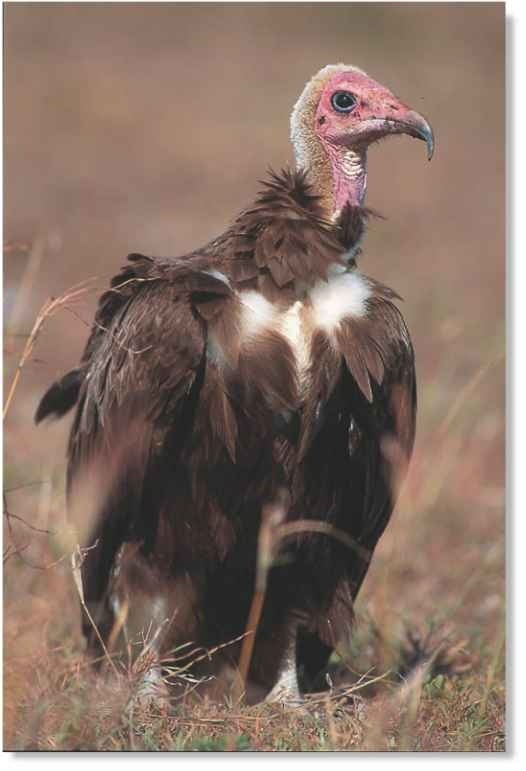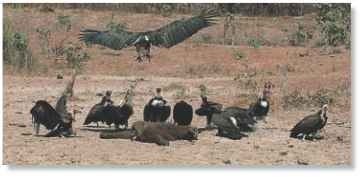ORDER
Falconiformes
FAMILY
Accipitridae
GENUS & SPECIES
KEY FEATURES
• Widespread in Africa, where it has learned to live closely
alongside humans in ! many parts of its range
• Scavenges almost any organic matter and so performs a garbage-disposal service around towns and cities
Attracted to farmland habitats, where carcasses of domestic livestock provide rich pickings
WHERE IN THE WORLD?
Found in Africa from Mauritania and Senegal east to [.Ethiopia and south to f South Africa; absent from the dense forests of western central Africa and Madagascar
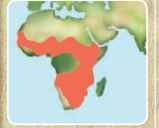
Lifecycle
A familiar visitor to sub-Saharan settlements in Africa, the hooded vulture boldly exploits human leftovers, scavenging scraps and waste from markets and city garbage dumps.
HABITAT
The vulture lives in a variety of African habitats, from coastal lowlands though semideserts to open woodlands and forests. It’s most widespread in savannahs and grassland, particularly near human settlements.
Towns and villages offer rich pickings to this scavenger. In parts of the sparsely populated grasslands of Tanzania and Kenya, the vulture settles near cattle ranches, gleaning scraps and carrion from around farms.
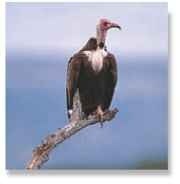
A Keeping an eye out A dead branch provides an ideal vantage point.
Landing site
The vulture frequents African grasslands.
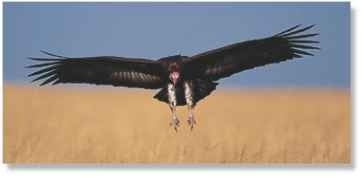
CONSERVATION
The hooded vulture isn’t threatened overall, but is listed in Appendix ll of CITES. Its populations are increasing locally around many human communities, but in parts of western and southern Africa, the species has been deliberately poisoned; in recent years it’s disappeared from much of the Sudan. However, the bird’s widespread integration with the human community will help ensure its survival.
BEHAVIOR
FOOD & FEEDING
Almost all of the vulture’s food is carrion and waste scraps. In open habitats, the vulture is often first to arrive at a carcass. This may not guarantee it a meal, though — its long, fine bill can’t tear through tough skin, and it may have to wait for bigger species to start the job. Even then, there may be a long wait while bigger; stronger birds have first pickings. Eventually when the others have left, the hooded vulture can dig in, picking into the tiny crevices and spaces too small to be probed by heftier bills.
In villages and towns, the vulture strolls the streets and markets in search for food. Almost anything is eaten: garbage-dump scraps, slaughterhouse waste, even human excrement.
LAST BUT NOT LEAST

The early bird…
The hooded vulture alights beside the carcass of a domestic ox, but its bill is too delicate to rip open the tough hide.
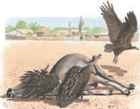
Mob rule…
Two Cape griffon vultures swoop down and aggressively drive away the hooded vulture. Their bills are able to tear into the carcass.

Second best…
Driven by hunger, the hooded vulture resorts to pecking for scraps of garbage at a dump on the outskirts of a village.

Next time around
A day or two later, the hooded vulture returns to the carcass. Little remains on the bones, but it reaches in to glean a few morsels.
The vulture tends to stay in the same area all year, roosting nightly in a tree and flying out daily to forage. Being smaller than other vultures, it tends to take flight earlier in the day. Its lighter body requires milder thermals (warm updrafts) to keep it aloft, so it doesn’t have to wait long for the morning sun to heat up the air
Vultures often flock in large numbers at rich feeding sites, especially near towns and villages and squabble noisily over food.
Dining out A baboon carcass draws a squabbling crowd.
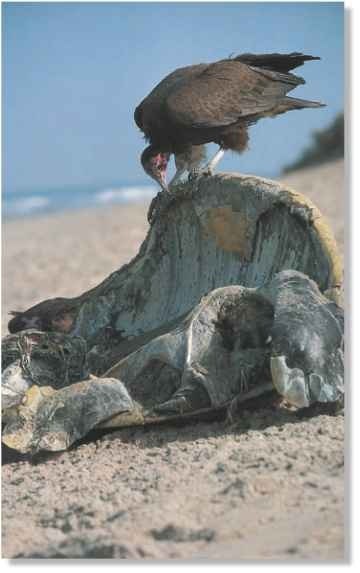
BREEDING
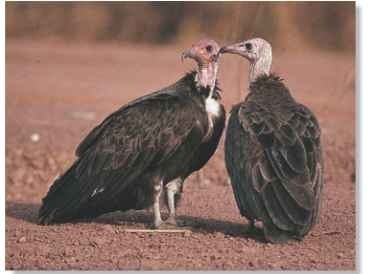
A Bosom friends Vultures pair for life and share parental duties.
The vulture’s breeding season varies according to location, but is usually timed so the egg is laid during, or just after, the
local rainy season, to ensure a reliable supply of food.
Adult birds, which pair for life, mate after a brief courtship. Their nest, built from sticks and lined with grass, bits of skin, hair or rags, is usually sited high in a tall tree; the same nest may be used for several years in succession. Incubation is carried out mainly by the female, and the single chick hatches less than two months later
The hatchling is feeble and helpless at first, needing care and attention from the adults, who take turns at brooding and feeding it. After remaining in the nest for about 14 weeks, the chick first climbs out to investigate the surrounding branches, but it may be another three weeks or so before it fledges and is ready to try its wings. Even then, the young vulture may remain roosting at the nest for a further month before finally leaving to become independent.
The hooded vulture’s scientific name Necrosyrtes monachus comes from Greek words that mean “monklike corpse-dragger,” referring to its cowl-like crown plumage and scavenging habits.
Vultures feature in many superstitions of native peoples. In parts of South Africa, there’s a belief that the hooded vulture always lays two eggs and that one of them hatches into a fly.
PROFILE
Hooded Vulture
The hooded vulture’s lean frame allows it to soar away on the mild, early morning air currents, giving it an advantage over heavier vultures.
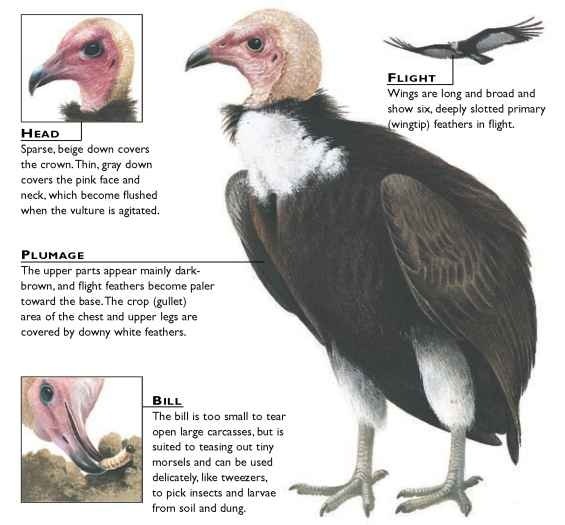
CREATURE COMPARISONS
The hooded vulture is dwarfed by some other species of Old World vulture.These include the African white-backed vulture (wingspan of 7′ and a weight of 16 lbs.), the lappet-faced vulture (spans up to 9′ and weighs 20 lbs.) and Eurasian black vulture (wingspan up to 9’8″ and more than 27 lbs.). Hooded vulture

Lappet-faced vulture
| VITAL | |
| STATISTICS | |
| Weight | 3.3-5.8 lbs. |
| Length | 26-27.5″ |
| Wingspan | 66-69″ |
| Sexual Maturity | 1 year |
| Breeding season | Year-round, but season varies with location |
| Number of Eggs | Usually |
| Incubation Period | 46-54 days |
| Fledging Period | 89-130 days; usually 95120 days |
| Typical Diet | Any form of carrion; dung and garbage; insects and their larvae |
| Lifespan | Not known |
RELATED SPECIES
• The hooded vulture is the only species in its genus. It’s related to f other Old World vultures, i | such as the Egyptian ! vulture (below). As a ; member of the family Accipitridae, it’s related to hawks, kites, harriers and eagles.

